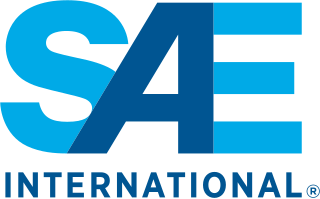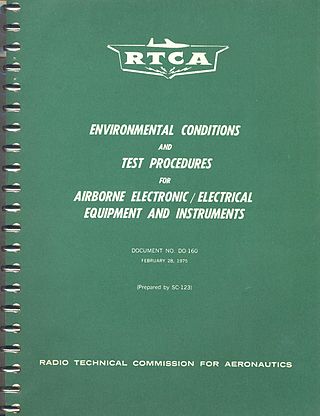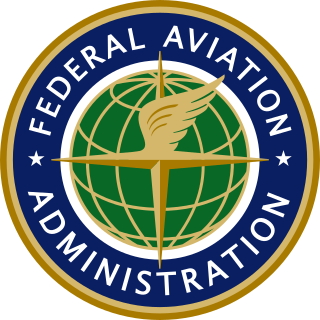Related Research Articles
DO-178B, Software Considerations in Airborne Systems and Equipment Certification is a guideline dealing with the safety of safety-critical software used in certain airborne systems. It was jointly developed by the safety-critical working group RTCA SC-167 of the Radio Technical Commission for Aeronautics (RTCA) and WG-12 of the European Organisation for Civil Aviation Equipment (EUROCAE). RTCA published the document as RTCA/DO-178B, while EUROCAE published the document as ED-12B. Although technically a guideline, it was a de facto standard for developing avionics software systems until it was replaced in 2012 by DO-178C.
A hazard analysis is one of many methods that may be used to assess risk. At its core, the process entails describing a system object that intends to conduct some activity. During the performance of that activity, an adverse event may be encountered that could cause or contribute to an occurrence. Finally, that occurrence will result in some outcome that may be measured in terms of the degree of loss or harm. This outcome may be measured on a continuous scale, such as an amount of monetary loss, or the outcomes may be categorized into various levels of severity.

ARP4754, Aerospace Recommended Practice (ARP) ARP4754B, is a guideline from SAE International, dealing with the development processes which support certification of Aircraft systems, addressing "the complete aircraft development cycle, from systems requirements through systems verification." Revision A was released in December 2010. It was recognized by the FAA through Advisory Circular AC 20-174 published November 2011. EUROCAE jointly issues the document as ED–79.
RTCA DO-254 / EUROCAE ED-80, Design Assurance Guidance for Airborne Electronic Hardware is a document providing guidance for the development of airborne electronic hardware, published by RTCA, Incorporated and EUROCAE. The DO-254/ED-80 standard was formally recognized by the FAA in 2005 via AC 20-152 as a means of compliance for the design assurance of electronic hardware in airborne systems. The guidance in this document is applicable, but not limited, to such electronic hardware items as
Integrated modular avionics (IMA) are real-time computer network airborne systems. This network consists of a number of computing modules capable of supporting numerous applications of differing criticality levels.

DO-160, Environmental Conditions and Test Procedures for Airborne Equipment is a standard for the environmental testing of avionics hardware. It is published by the Radio Technical Commission for Aeronautics (RTCA) and supersedes DO-138.

LDRA is an independent, privately owned, provider of software analysis, test, and requirements traceability tools for the Public and Private sectors.
DO-178C, Software Considerations in Airborne Systems and Equipment Certification is the primary document by which the certification authorities such as FAA, EASA and Transport Canada approve all commercial software-based aerospace systems. The document is published by RTCA, Incorporated, in a joint effort with EUROC and replaces DO-178B. The new document is called DO-178C/ED-12C and was completed in November 2011 and approved by the RTCA in December 2011. It became available for sale and use in January 2012.

Advisory circular (AC) refers to a type of publication offered by the Federal Aviation Administration (FAA) to "provide a single, uniform, agency-wide system … to deliver advisory (non-regulatory) material to the aviation community." Advisory circulars are now harmonized with soft law Acceptable Means of Compliance (AMC) publications of EASA, which are nearly identical in content. The FAA's Advisory Circular System is defined in FAA Order 1320.46D.

AC 25.1309–1 is an FAA Advisory Circular (AC) that identifies acceptable means for showing compliance with the airworthiness requirements of § 25.1309 of the Federal Aviation Regulations. Revision A was released in 1988. In 2002, work was done on Revision B, but it was not formally released; the result is the Rulemaking Advisory Committee-recommended revision B-Arsenal Draft (2002). The Arsenal Draft is "considered to exist as a relatively mature draft". The FAA and EASA have subsequently accepted proposals by type certificate applicants to use the Arsenal Draft on development programs.

FAA Order 8130.34D, Airworthiness Certification of Unmanned Aircraft Systems, establishes procedures for issuing either special airworthiness certificates in the experimental category or special flight permits to unmanned aircraft systems (UAS), optionally piloted aircraft (OPA), and aircraft intended to be flown as either a UAS or an OPA.

The Advisory Circular AC 20-115( ), Airborne Software Development Assurance Using EUROCAE ED-12( ) and RTCA DO-178( ), recognizes the RTCA published standard DO-178 as defining a suitable means for demonstrating compliance for the use of software within aircraft systems. The present revision D of the circular identifies ED-12/DO-178 Revision C as the active revision of that standard and particularly acknowledges the synchronization of ED-12 and DO-178 at that revision.

FAA Order 8110.105B, Airborne Electronic Hardware Approval Guidelines is an explanation of how Federal Aviation Administration (FAA) personnel can use and apply the publication

The Advisory Circular AC 20-152A, Development Assurance for Airborne Electronic Hardware, identifies the RTCA-published standard DO-254 as defining "an acceptable means, but not the only means" to secure FAA approval of electronic hardware for use within the airspace subject to FAA authority. Commonly, the DO-254 has been interpreted as applying to complex custom micro-coded components within aircraft systems with Item Design Assurance Levels (IDAL) of A, B, or C. However, Revision A of this AC clarifies that AC 20-152 and DO-254 applies to all type certification of all electronic hardware aspects of airborne systems, including all electronic hardware that is not complex, that is, "simple electronic devices". Revision A also defines objectives in addition to those identified in DO-254; applicants choosing to follow DO-254 under the authority of AC 20-152A must also accomplish these additional objectives.
DO-248C, Supporting Information for DO-178C and DO-278A, published by RTCA, Incorporated, is a collection of Frequently Asked Questions and Discussion Papers addressing applications of DO-178C and DO-278A in the safety assurance of software for aircraft and software for CNS/ATM systems, respectively. Like DO-178C and DO-278A, it is a joint RTCA undertaking with EUROCAE and the document is also published as ED-94C, Supporting Information for ED-12C and ED-109A. The publication does not provide any guidance additional to DO-178C or DO-278A; rather, it only provides clarification for the guidance established in those standards. The present revision is also expanded to include the "Rationale for DO-178C/DO-278A" section to document items that were considered when developing DO-178B and then DO-178C, DO-278A, and DO-330, as well as the supplements that accompany those publications.
CAST-32A, Multi-core Processors is a position paper, by the Certification Authorities Software Team (CAST). It is not official guidance, but is considered informational by certification authorities such as the FAA and EASA. A key point is that Multi-core processor "interference can affect execution timing behavior, including worst case execution time (WCET)."
DO-297, Integrated Modular Avionics (IMA) Development Guidance and Certification Considerations is one of the primary document by which certification authorities such as the FAA and EASA approve Integrated Modular Avionics (IMA) systems for flight. The FAA Advisory Circular (AC) 20-170 refers to DO-297.
The Advisory Circular AC 00-69, Best Practices for Airborne Software Development Assurance Using EUROCAE ED-12( ) and RTCA DO-178( ), initially issued in 2017, supports application of the active revisions of ED-12C/DO-178C and AC 20-115. The AC does not state FAA guidance, but rather provides information in the form of "best practices" complementary to the objectives of ED-12C/DO-178C.

CAST-31, Technical Clarifications Identified for RTCA DO-254 / EUROCAE ED-80 is a Certification Authorities Software Team (CAST) Position Paper. It is an FAA publication that "does not constitute official policy or guidance from any of the authorities", but is provided for educational and informational purposes only for applicants for software and hardware certification.

CAST-15, Merging High-Level and Low-Level Requirements is a Certification Authorities Software Team (CAST) Position Paper. It is an FAA publication that "does not constitute official policy or guidance from any of the authorities", but is provided to applicants for software and hardware certification for educational and informational purposes only.
References
- 1 2 3 Leanna Rierson (19 December 2017) [7 January 2013]. Developing Safety-Critical Software: A Practical Guide for Aviation Software and DO-178C Compliance. CRC Press. pp. 52–55. ISBN 9781351834056 . Retrieved 2022-03-03.
- ↑ Cary Spitzer; Uma Ferrell; Thomas Ferrell, eds. (2015). Digital Avionics Handbook, Avionics, Development and Implementation (3rd ed.). Boca Raton, FL: CRC Press. pp. 14–18. ISBN 978-1138076983.
CAST was formed to promote harmonization of certification and regulatory positions on software and complex hardware aspects of safety.
- ↑ Rierson. p. 289-313.
- ↑ Cary Spitzer; Uma Ferrell; Thomas Ferrell, eds. (2015). Digital Avionics Handbook, Avionics, Development and Implementation (3rd ed.). Boca Raton, FL: CRC Press. pp. 14–18. ISBN 978-1138076983.
CAST position papers are for education and information purposes and do not constitute official [FAA] policy or guidance.
- 1 2 "Certification Authorities Software Team (CAST)". Federal Aviation Administration. Retrieved 2021-10-29.
- ↑ "ANAC-EASA-FAA-TCCA Certification Management Team Collaboration Strategy" (PDF). Federal Aviation Administration. 2016. Retrieved 2021-10-29.
The CMT should actively engage with industry and promote common solutions and approaches to aircraft certification within the international community.